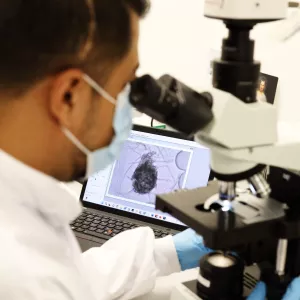None Shall Pass: How Germplasm Health Units Prevent the Spread of Pests and Diseases
The Germplasm Health Units are CGIAR’s first line of defence against the cross-border spread of pests and diseases through germplasm. On International Plant Health Day, we highlight their vital work and explore their ambitious plans as part of the 2025-2030 Genebanks Accelerator. Food systems are heavily interconnected. On average, nearly 70% of crops consumed or produced in a country originate

None Shall Pass: How Germplasm Health Units Prevent the Spread of Pests and Diseases
The Germplasm Health Units are CGIAR’s first line of defence against the cross-border spread of pests and diseases through germplasm. On International Plant Health Day, we highlight their vital work and explore their ambitious plans as part of the 2025-2030 Genebanks Accelerator.
Food systems are heavily interconnected. On average, nearly 70% of crops consumed or produced in a country originate from a different part of the world.
It is therefore essential to share planting material across national borders to give farmers resilient, sustainable options. But this needs to be done with great care to avoid spreading pests and diseases.
The role of Germplasm Health Units
For over 50 years, Germplasm Health Units (GHUs) have been leading this effort on behalf of CGIAR. They offer biosecurity to the crop diversity collections that CGIAR genebanks manage and serve as a gateway for the global distribution of genetic material from both the genebanks and breeding programs.

The ten GHUs work closely together to harmonize protocols and ensure that they all meet the highest safety standards, in accordance with the FAO International Plant Protection Convention and national quarantine laws. Their work also contributes to Target 6 (Reduce the Introduction and Impact of Invasion Alien Species) of the Convention on Biological Diversity.
They also co-create innovations that are crucial for the detection and phytosanitation of seed-borne pests and diseases. That includes genomic-based molecular methods and bioinformatics, both of which have delivered precision and significant time savings.
Germplasm Health is one of the five core areas of work under the Genebanks Accelerator, part of CGIAR’s 2025-2030 Research Portfolio. As we reach out to new users and as new pests and diseases emerge, biosecurity work will become even more important.
Innovation for better detection and therapy
As part of the new Accelerator, the GHUs will pioneer advanced diagnostics to detect threats faster and more accurately. This will include high-throughput sequencing methods and AI-based multispectral imaging for non-invasive screening.
They will also continue to develop and improve interventions and therapies to generate pest-free germplasm. They aim to develop more effective therapies for virus elimination in clonal crop plant material and alternative seed-treatment chemicals to comply with the UN SDG agenda on phasing out highly hazardous pesticides by 2035. The units will also explore data analytics and modelling to predict pest and disease risks due to climate change.

Partnerships for a stronger global system
CGIAR is not alone in the fight against pests and diseases. Under the new Accelerator, the GHUs will strengthen collaboration with National Plant Protection Organizations to transfer technology, share knowledge, build capacity and co-design solutions to control invasive threats to biodiversity.
They will also advocate for a systems approach to certification of germplasm seed material – known as a Green Pass – to reduce delays while ensuring safe distribution to those that need it.
Work on germplasm health is not an optional extra. It is essential if we are to give farmers, breeders and researchers access to the healthy plant germplasm they need to develop improved varieties, organize international trials, and grow nutritious food in a changing climate.

